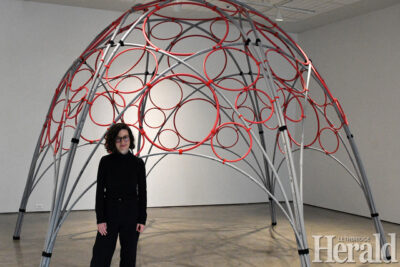New exhibitions open today at the SAAG
By Theodora MacLeod - Lethbridge Herald Local Journalism Initiative Reporter on January 27, 2024.
 Herald photo by Theodora MacLeod
Noa Bronstein, curator of the SAAG exhibition 'Structural Integrity', stands in front of a piece included in her exhibition made from PVC pipe by Quebec artist Caroline Monnet. The exhibition is one of three opening at SAAG on Saturday.
Herald photo by Theodora MacLeod
Noa Bronstein, curator of the SAAG exhibition 'Structural Integrity', stands in front of a piece included in her exhibition made from PVC pipe by Quebec artist Caroline Monnet. The exhibition is one of three opening at SAAG on Saturday.The first Southern Alberta Art Gallery exhibitions of 2024 open today with a variety of artistic styles and mediums on display.
Featuring the works of five artists – three of whom are part of a curated show – the pieces address concepts of self-identity and expression, architecture as a reflection of social history, and the relationship between Indigenous people and dogs pre-colonization and today.
Starting at 1:30 p.m. exhibiting artist Bridget Moser of Toronto, will take centre stage in the Upper Gallery performing her piece “The Worm That Destroys You.”
The performance, Moser says, includes, “personas of women behaving badly and being confused but doing their best.” As part of her solo exhibition “A Malevolently Bad Map,” Moser combines performance art, video, and installation in her absurd and comedic reflection on the “consumerization of self-expression.”
Featuring a cult-esque gathering of lawn chairs bearing witness to the declaration of a fellow chair in the desert, Moser says it started with a bad idea.
Though she won’t reveal what the original bad thing was, she says the process was about challenging herself in relation to this unspoken bad idea or bad thing, and “seeing if I could engage with it in a way that was interesting to me.”
Occupying the upper gallery with its arch windows and beams of natural light, the exhibit features a knock-off designer chair based on a modern design from the 1980s that fails to align comfort and utility within its structure. Moser says,
“There’s something about coming to understand some aspect of yourself that is inconvenient or that you wish was different and learning to live with it.”
She says the chair is a symbol of that inconvenience. A second video, set up on a lawn chair at the head of the cult-like chair gathering displays “There’s some dialogue about what kind of chairs do normal people have, and the result is normal people just have normal chairs.”
Within that dialogue are real statements from cult leader Marshall Applewhite.
Following Moser’s performance, at 2 p.m., Toronto based curator Noa Bronstein and artist Sikapinakii Low Horn of Siksika First Nation will offer a tour of the other new exhibitions.
“Structural Integrity” features works by Christine Howard Sandoval, Caroline Monnet, and Erdem Tasdelen. Curated by Noa Bronstein, the collection explores the concept of architecture as an archive.
“All of these artists, through the kind of works that they’re doing are really inviting viewers to read beyond the surface of architecture,” says Bronstein.
“Really to think about the kind of histories folded into a space.”
Each of the works centres around a strong historic element.
Erdem Tasdelen’s piece, ‘A Minaret for the General’s Wife’ revolves around a free-standing minaret in Lithuania built in 1880 by a Russian general. Capturing both the documented history and the folklore associate with the structure, TaÅŸdelen’s installation uses a variety of materials meant to look like props to capture varying perspectives and represent how public spaces are conceptualized.
Bronstein says the piece including its props are meant to look staged, as if any moment someone could walk in and perform. Bringing in elements of the location the work is being shown, it includes a custom movie poster and a piece of rock from Galt Gardens.
While some choose clay and others paint, Christine Howard Sandoval chose adobe when creating her works. Using thick layers of the dirt-sand-water mixture over strips of tape, she creates negative space by removing the tape and leaving lines of adobe in various thicknesses.
The delicate compositions are a reference to colonization and the missions that were built throughout the western United States by an indentured workforce using adobe.
Bronstein explains that some of Howard Sandoval’s ancestors were among those who built the mission in Soledad, California.
The work also honours the matrilineal legacy of women who were adobe brick makers on the other side of her family.
Foraging for the materials needed to make the thick mud-like substance, her approach steps beyond an intellectual understanding of ancestry into an embodied and engaged connection with her past. Though the pieces appear very fragile, Bronstein says they are surprisingly resilient.
Caroline Monnet’s work is made using common construction materials such as insulation material, PVC pipes, Tyvek and other weather proofing materials. Her art addresses some of the conditions caused by the Indian Act and the harmful effect it had on Indigenous homes in the 1930s when legislative restrictions imposed upon Indigenous communities greatly impacted the quality and quantity of building supplies they could use, and in turn the conditions people lived in.
Additionally, it reflects upon the long-lasting environmental impacts modern materials have on the environment.
Bronstein says she chose the artists and their works because,
“They’re three artists that think around ideas of architecture as an archive. That was the starting place of the exhibition for me. So yes, it’s material in one sense, but it’s also very much a social construct. Of course, it’s a physical container, it’s tangible, but it’s also intangible in that it’s a container of, or memory, of history, of social stories, and like and archive it completely shifts over time. Our understanding of it shifts over time, the way we engage with it shifts over time. It’s never sort of static.”
In the Library Gallery, Sikapinakii Low Horn’s “Imiitaik’iistsik’ooni” honours dogs and their long history of protection, companionship, and work along Indigenous people.
Meaning, ‘the dog days,’ “Imiitaik’iistsik’ooni” refers to a time before horses were used by the Blackfoot people and instead dogs accompanied them as they travelled.
“You can tell when the dog days era is in photos… by the size of the tipis, because the tipis are much smaller because the dogs hauled them,” says Low Horn. Represented through a mural that features a striking and somewhat unconventional pallet of colours, imagery of southern Alberta’s landscape including mountains, prairies, and chinooks provides the backdrop for a black and white spotted dog featuring traditional Blackfoot iconography representing life.
Creatively using the space, Low Horn uses the windows, which have images of tipis on them, that, from the right angle align with the mural to create another dimension to the work, as well as the bookshelves, which display early renditions of the mural, along with pictures of a very important piece of inspiration, Low Horn’s recently passed pup, Apikayii.
The exhibition openings will run from 6 to 8 p.m. tonight. The exhibitions will be on until April 20.
32-31




